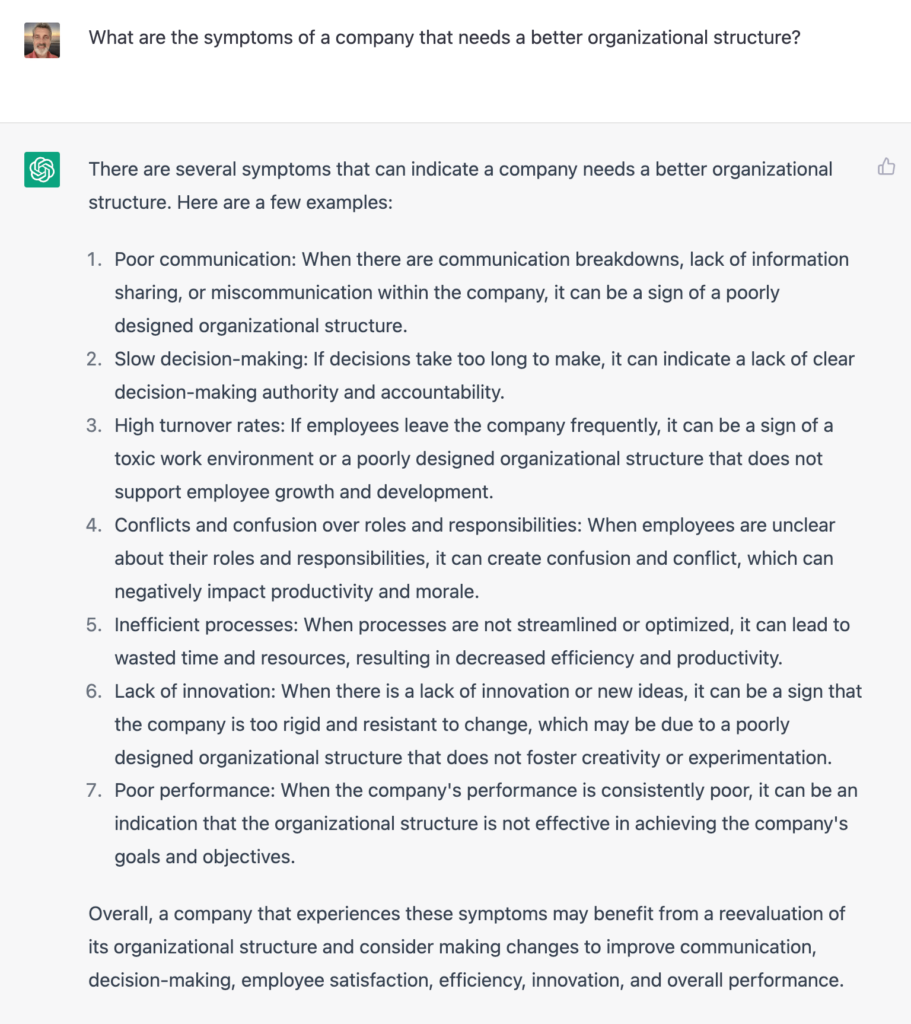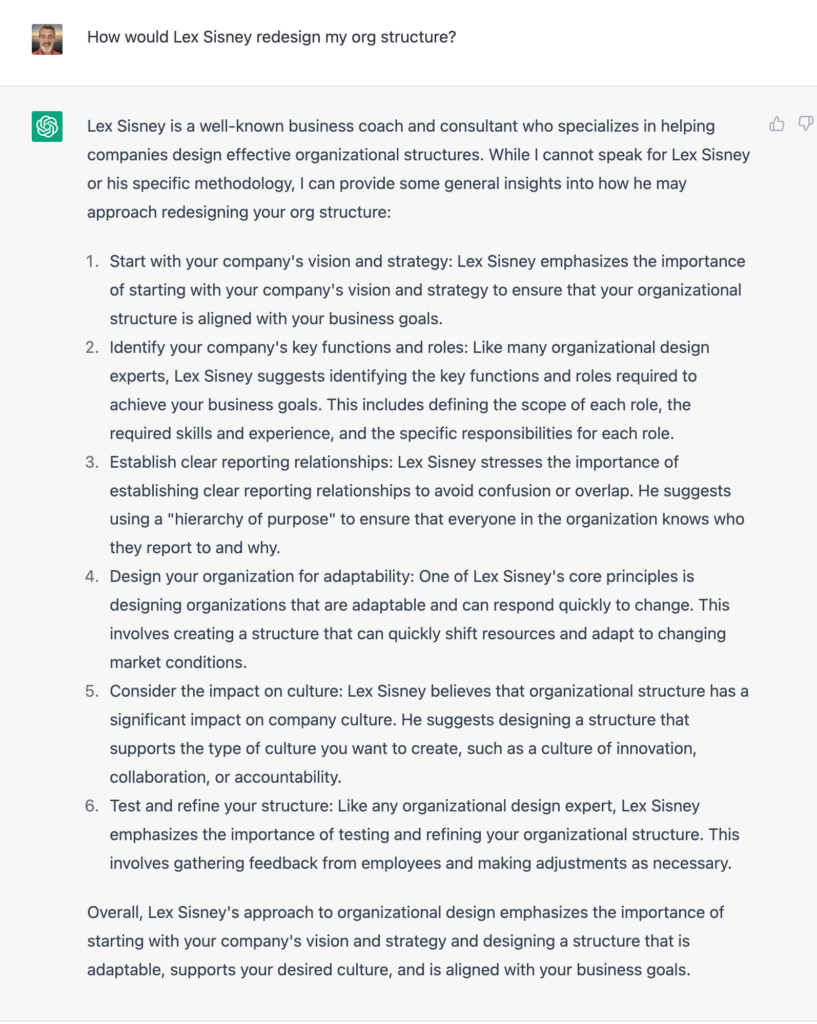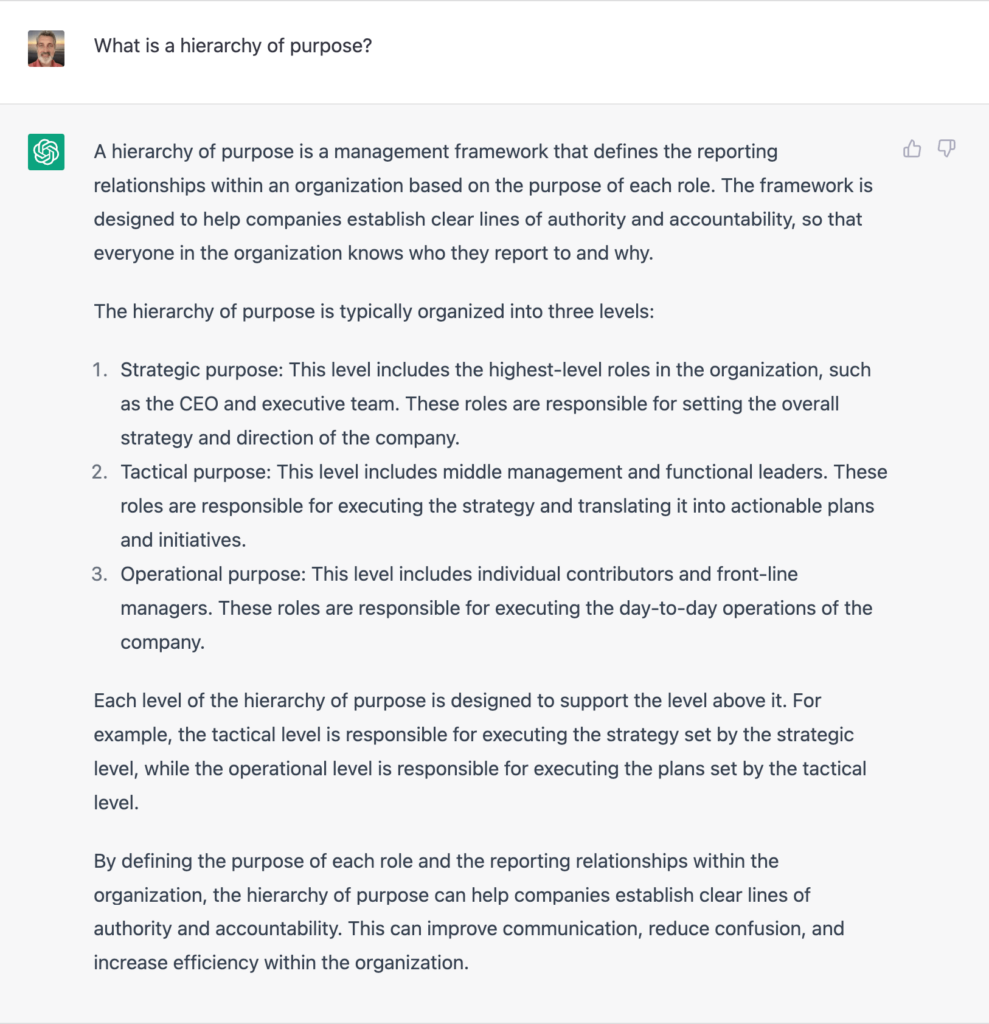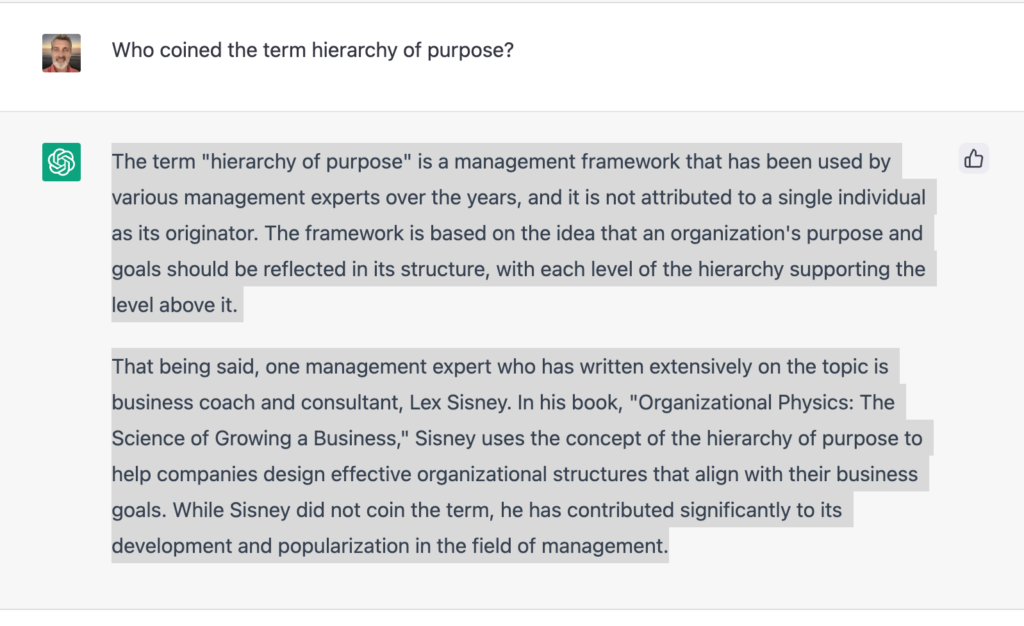Design for Purpose, Not Politics
Summary Insight:
ChatGPT gave me a better name for my life’s work than I ever did: the hierarchy of purpose. Structure isn’t about titles — it’s about supporting strategy at every level of execution.
Key Takeaways:
- Don’t design for hierarchy — design for purpose.
- Your org structure should serve strategy, not internal politics.
- Structure has three levels: strategic, tactical, operational — all driven by role clarity, not job titles.
Today, I had a matrix-like experience using ChatGPT. I was asked by a freelance journalist on LinkedIn if I had any comments to share about an article she was writing about culture and structure.
In light of ChatGPT’s recent beta release, I was curious to see how it would perform. So I asked it the same question the reporter asked me: “What are the symptoms of a company that needs a better organizational structure?”
I thought. “Not bad! There’s no indication as to why those symptoms occur, or what to do about them, but it’s not a bad summary by ChatGPT.”
I then took a flyer and asked it another question. “How would Lex Sisney redesign my organization structure?”
I think this summary captures my approach to changing organizational structures very well. But the thing is that I never used the term “hierarchy of purpose” in any of my writings. I had never heard of this term before reading this, so being called an expert was quite amusing. The concept sounded cool, however, and I liked it a lot. So I asked ChatGPT, “What is a hierarchy of purpose?”
Holy Toledo. My work has been defined by ChatGPT in a way I haven’t even articulated to myself. For years, I have been teaching a hierarchy of purpose model without ever referring to it as such. It’s kind of surreal.
After that, I wondered, “Who came up with this hierarchy of purpose concept and why hadn’t I heard of it before?” So I asked ChatGPT, “Who coined the phrase hierarchy of purpose?”
Too funny, right? Again, just so we’re clear, ChatGPT is making this interpretation of my work. Although I haven’t used the term “hierarchy of purpose” before, I like the concept it conveys. It captures the spirit of my work in a new and insightful way.
Anyway, the novelty of ChatGPT will eventually wear off and the reality of needing to design a hierarchy of purpose will remain. So how do you do that?
How to Design Your Structure Using a Hierarchy of Purpose
The most important thing to remember when designing your company’s structure is to design it to support the business strategy, rather than to satisfy perceived internal corporate needs.
For instance, in my book Designed to Scale, I share a story of a company that wanted to get my opinion on their org “structure.” They put a slide on the shared zoom screen: “We think we’ve thought this through pretty well already. We have three internal levels for employees to progress through: Managers, Directors, and VPs. We like this approach because we want to show our employees their future career progression in the structure.”
Can you see how this company created a hierarchy for hierarchy’s sake and not one that is fit for purpose?
When designing your organizational structure, you can avoid this trap by putting aside all thoughts of job titles, people, career paths, or other perceived internal needs. Start from a blank slate and, starting with business strategy, follow the 5 Steps to Designing a New Structure:
Step 1. Map Key Process Cycles
Step 2. Map Functions
Step 3. Clarify & Adopt Structure
Step 4. Place People
Step 5. Plan & Execute Roll Out
Following these steps in sequence will result in a flat structure (as flat as possible). There will, however, be a hierarchy. As ChatGPT so kindly brought to my attention, it will consist of three basic levels.
There is a Strategy Level. This level should consist of a critical number of functional heads (generally 10 to 15 people total, but it depends on your organization’s size and complexity) from all four quadrants of your organization. Here is the team, which I usually call the Leadership Team, but you can call it whatever you like, that exists for only one reason. Can you guess what the reason is? To drive forward the short-range tactics of the long-range strategy. This team follows the format and principles of the Ultimate Leadership Team Process.
Then there is the Tactical Level. The members of a team at this level are usually directors and managers with key roles to play within a given function. These members often participate on the Cascading Objectives team and are instrumental in supporting key projects and initiatives as technical experts and as up-and-coming leaders.
Then there is the operational level. There is an operational home for everyone in the company. Even in a matrix organization consisting of cross-functional teams or pods, every pod member has a home base. If a software engineer is dedicated full-time to a product line, he or she still has a home base within the software engineering function.
You don’t need to create extra management levels for the operational level. But it is valuable to have a role scorecard for each role in the company that explains concisely why the role exists and provides a concise definition of what that role entails. Role description includes the role name, role purpose, role accountabilities, desired PSIU style, and Key Performance Indicators (KPIs) for this role. This is not a job description, but a brief and punchy role description. In this way, employees learn to play roles rather than inhabit a “title.”
Summary of the Hierarchy of Purpose
I’d like you to reflect with me on what we’ve just done. Your company’s strategy is its most critical success factor*. To support that evolving strategy, we designed a hierarchy of purpose. There is no emphasis on job titles, career paths, or creating hierarchies for the sake of hierarchy. The hierarchy should only exist to drive forward the evolving business strategy.
Whether you like it or not, there is a hierarchy in your company. The key is to get that hierarchy working for the short-range and long-range success of the business, not for its perceived internal needs. This requires a designer’s mentality and the awareness and skills to adapt the structure and key processes to better fulfill the organization’s purpose.
Your existing structure influences the behavior of everyone in your company. Under its own inertia, a flawed structure or an over emphasis on internal needs, makes it hard to get the business to enact new behaviors. Keep this principle in mind when it’s time to design your organization for the next stage of growth. Design for purpose and not for hierarchy.
* I know that I’m creating disagreement and confusion amongst some readers as to why I list strategy as the most important purpose and not vision and values or making money. The most important part of your business is your strategy, because if your strategy zigs while the environment zags, your business won’t survive. Having the right strategy and pursuing it efficiently and effectively are the keys to realizing your vision and making money. You can learn more about this concept by reading Part III of Organizational Physics.








